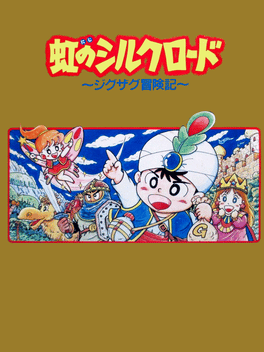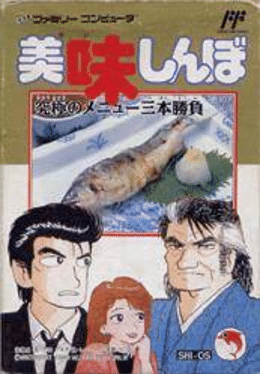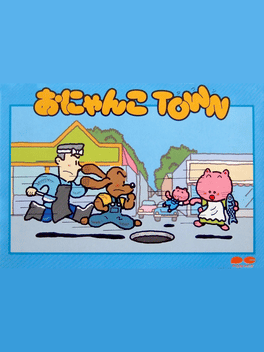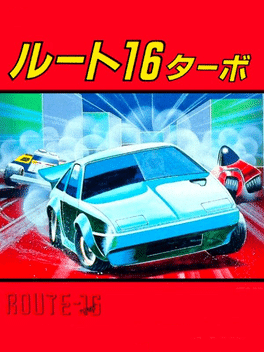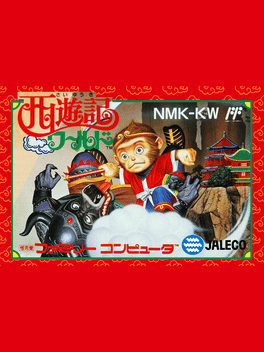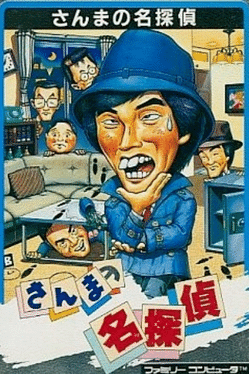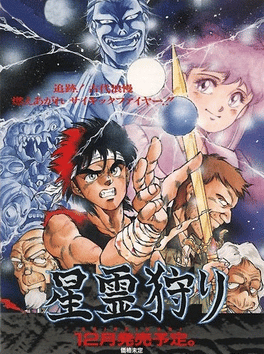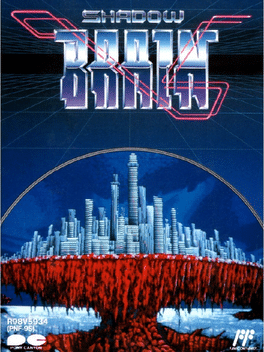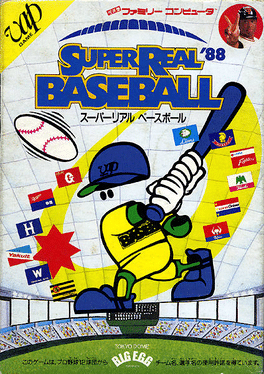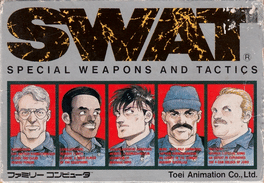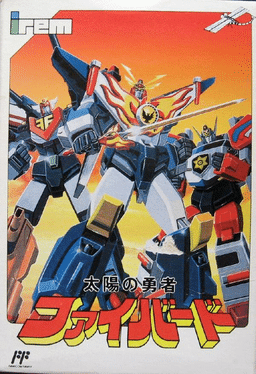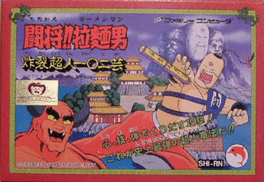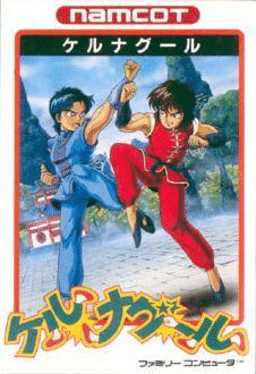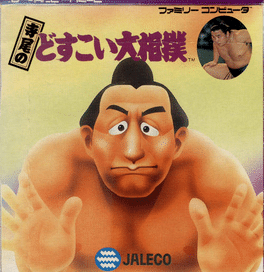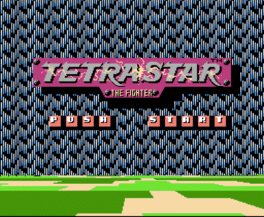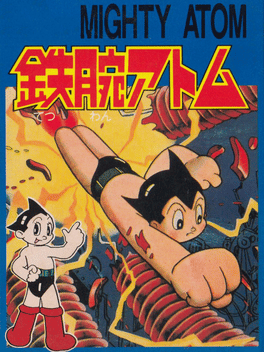Most Popular Famicom Games - Page 45
-
Niji no Silkroad
1991
Niji no Silkroad
1991
Niji no Silkroad is a role-playing video game for the Japanese version of the NES, the Famicom. It was developed by NHK and published by Victor Interactive Software (now Marvelous Entertainment) in 1991. The game was only released in Japan. The player controls the main protagonist, an exiled prince of LittleLand that has been recently informed of his royal heritage. To reclaim the throne, the prince must collect seven shards of the Rainbow Mirror and defeat the usurper, Zrool. The shards are scattered throughout South Asia and the prince must trade goods to make his way to each region. Once the mirror is collected, the prince shines it at Zrool and exposes the imposter. The prince then takes his throne as the new king. -
Ninjara Hoi!
1990
Ninjara Hoi!
1990
Ninjara Hoi! is a Role-Playing game, developed and published by ASCII Entertainment, which was released in Japan in 1990. -
Oishinbo: Kyuukyoku no Menu 3-bon Shoubu
1989
Oishinbo: Kyuukyoku no Menu 3-bon Shoubu is an Adventure game, developed by TOSE and published by Bandai Shinsei, which was released in Japan in 1989. -
Onyanko Town
1985
Onyanko Town
1985
Players must play the role of a mother cat called Milky who lives in a dangerous metropolis full of dogs. The dogs want to kill Milky before she can rescue her son Michael who wandered out into the city on his own (and became lost). Players must catch the fish for temporary invincibility. However, the other enemies can still kill the mother cat like the fish merchant (who is the only humanoid bad guy in the game), the automobiles on the road, along with the manholes and the pylons. The city is divided into roads for automobile traffic and sidewalks for roaming pedestrian dogs in overalls. The fish merchants completely replace the dogs after the 30th level; causing the invincibility icon (fish) to become redundant. Unlike the Teenage Mutant Ninja Turtles series of video games (especially the first NES release which would come out four years later in 1989), open manholes kill the player instead of helping her evade the roaming dogs. Sewer snakes also come out to kill the player with its poisonous venom. Triangle con -
Route-16 Turbo
1985
Route-16 Turbo
1985
Route-16 Turbo is an improved version of Route-16 for the Famicom which was published on October 4, 1985 by Sunsoft only in Japan. Route-16 Turbo added multiple difficulty levels and improved graphics and music. In Route-16 Turbo, players get behind the wheel of a car and drive around trying to collect valuable items lying around on the road while avoiding chase cars whose only purpose is to crash into the player's car. In the game, the player's car drives around on a map that contains a bird's eye view of the 16 different routes (individual maze rooms) that can be entered. This overhead map screen shows which routes contain the items that have to be collected. Each item the player collects will increase their score. Collecting all the items in a level will allow the player to go on to the next round. When the player enters a specific route, the game switches its view to a single screen maze. These mazes contain dead-ends, zig-zags, multiple exits, enemy obstacles, with also the the threat of the chase cars ente -
Saiyuuki World
1988
Saiyuuki World
1988
Saiyuuki World is an action game based on Wonder Boy in Monster Land but modified with content from the classic Chinese novel Journey to the West. -
Sanma no Meitantei
1987
Sanma no Meitantei
1987
Sanma no Meitantei is a murder mystery detective adventure game developed and published by Namco for the Famicom in 1987. In the vein of Portopia Renzoku Satsujin Jiken, the player must visit several locations associated with the murder victim, to discover clues which will open up more locations in order to find more clues until ultimately, the identity of the murderer can be confirmed. The game is played entirely in Japanese and was never translated into English. The summary of the story is that while the president Yoshimoto held a party at his villa, Katsura Buntin was found to have been killed in the vault. On top of that, the "Star of Africa" diamond that was stolen from the vault. As detective Sanma Akashiya's assistant, you must help him determine the perpetrators of the incident. The game features a mini game which is a parody of Galaxian, and contains sound effects from other Namco hits such as Dig Dug and Xevious -
Sansara Naga
1990
Sansara Naga
1990
Sansara Naga is a role-playing video game that was published by Victor Music Entertainment exclusively to Japan for the Family Computer on the 23rd of March, 1990. A fan-translation was finished and released in 2013 on the 28th of December for Sansara Naga by the hacking and translation group Stardust Crusaders. Sansara Naga is set in the fantasy-filled lands of India during the Vedic age and also mixes elements of Japanese folklore such as the legend of Brahman Umibouzu ("sea bonze"). Many of the NPCs in game will tell you that Cows are sacred animals and a few will mention the Tower of Ṛta Satya. There is a set of armor in the game called Dharma Armor, which will prevent the player from dealing or being dealt damage. The story revolves around a Boy/Girl that steals a treasured Ostrich egg from the village of Orissa and decides to reflect upon one's actions; aspiring to become a Dragoon to restore their lost honor. The protagonist will set out on an adventure saving lives, performing good deeds, and raising a -
Seirei Gari
1989
Seirei Gari
1989
Seirei Gari is an Adventure game, developed by Advance Communication Company and published by Hudson, which was released in Japan in 1989. -
Shadow Brain
1991
Shadow Brain
1991
Shadow Brain is a Role-Playing game, developed by Scitron & Art and published by Pony Canyon, which was released in Japan in 1991. -
Sherlock Holmes: Hakushaku Reijou Yuukai Jiken
1986
Sherlock Holmes: Hakushaku Reijou Yuukai Jiken (loosely translated as Sherlock Homes: Kidnapping of the Young Countess) is an adventure game developed for the Famicom by Towachiki, and released in 1986. The game puts the player in the role of Sherlock Holmes, who must travel throughout England (by train) while trying to solve the mystery of a kidnapping. In this unusual portrayal of Holmes, his only means of interrogating anyone to obtain information is by attacking them with jump kicks until they run out of stamina and reveal clues. The game alternates between a zoomed out view of England streets, where every bystander can damage Holmes simply by running in to him, to a zoomed in side scrolling view of buildings or sewers or parks. Besides interrogating people for information, or simply beating them up for train fare, Holmes must search seemingly random cracks or trees in order to find important clues, or inventory items. -
Super Real Baseball '88
1988
Super Real Baseball '88 is a baseball game developed by Pax Softonica for the Famicom and published in Japan by Vap in 1988. After Namco excited the market for baseball games with the release of Pro Yakyuu Family Stadium, many other companies attempted to meet the demand for more baseball games. This title differentiated itself from other baseball games by obtaining permission from the Professional Baseball Organization of Japan to use the official names of the 12 Japanese baseball teams and their players. This was a groundbreaking feature at the time. It was also the first game to depict an existing stadium with it's actual name, the Tokyo Dome, which had just opened shortly before the game's release. Outfielder and first baseman Warren Cromartie, formerly with the Montreal Expos, and playing for the Yomiuri Giants at the time, was chosen to help promote the game. To further distinguish the game, the developers chose to use a more realistic approach when depicting the players on the field, as opposed to the more -
Super Star Pro Wrestling
1990
Super Star Pro Wrestling is a 1989 Japanese professional wrestling, or puroresu, game made by Nihon Bussan and published by Pony Canyon for the Nintendo Famicom system. Released December 9, 1989, the game features play for both one- and two-player modes. It was released a year later in the United States as WCW Wrestling on the Nintendo Entertainment System, with different wrestlers. The game featured several puroresu legends of the era, including Giant Baba, Antonio Inoki, and Stan Hansen. There are some inaccuracies in the game, mainly with the birthdates of some of the wrestlers, and Big Van Vader's hometown and date of birth are not listed in order to protect his gimmick. The only two wrestlers to appear in both Super Star Pro Wrestling and WCW Wrestling are Road Warrior Hawk and Road Warrior Animal. -
SWAT: Special Weapons and Tactics
1987
SWAT: Special Weapons and Tactics is a role-playing game developed by Shouei and published by Toei Animation. This game was only ever released in Japan for the Famicom and was never translated from the original Japanese language. The player takes control of a five member team of special anti-terrorist agents as they break into a building where a hostage situation is taking place. Their goal is to take out the villains and free the hostages. Battles with gunmen take place in a traditional RPG style turn-based battle. Players enter the commands for each surviving member of the team, including what weapon to attack with, and which target to attack. When not in battle, the player views the building in a traditional 3D dungeon perspective, moving through the hallways, choosing which rooms to investigate, which traps to disarm, and how to proceed to the end of the game within a given time limit. -
Taiyou no Yuusha Fighbird
1992
Taiyou no Yuusha Fighbird is an Action game, developed by Tamtex and published by Irem, which was released in Japan in 1992. -
Tatakae!! Ramen-Man: Sakuretsu Choujin 102 Gei
1988
Tatakae!! Ramen-Man: Sakuretsu Choujin 102 Gei is an adventure game developed by Human Entertainment for the Famicom and published by Bandai in 1988. It is based off the Tatakae!! Ramenman series, which itself is a spin-off of the Kinnikuman series, known in the US as M.U.S.C.L.E.. Ramenman is a popular character in the Kinnikuman universe. The game follows the eponymous warrior Ramenman as he attempts to track down his father's killers and bring them to justice with his many years of martial arts training. Notably, this game is the first true point-and-click adventure game for the system. While there had been many adventure games made for the NES, such as Portopia Renzoku Satsujin Jiken or Princess Tomato in the Salad Kingdom, they are largely driven by menus. Ramenman is directed by using the cursor to select an area to walk to or interact with instead much like classic Sierra adventure games such as King's Quest. -
Tenkaichi Bushi: Keru Naguuru
1989
Become the strongest warrior in the world! With the support of your mother and amazing martial arts skills, roam the world to find quests and opponents to hone your skills and become the legend of fighting. -
Terao no Dosukoi Oozumou
1989
Terao no Dosukoi Oozumou is a Sports game, developed by TOSE and published by Jaleco Entertainment, which was released in Japan in 1989. -
Tetrastar: The Fighter
1991
Tetrastar The Fighter is a 3D shooter by Home Data and published by Taito. In the year 2089, humanity forms an alliance with the intergalactic Baal empire but soon Earth finds out about the alien's true intentions. A group of resistance assembles the project Tetrastar to prepare for the potential upcoming threat. But the project lead by the general Nelson is soon put on hold and a short lived peace settles in. But the whole thing was nothing more than a hostile invasion and the Baal empire finally breaks the alliance and attacks Earth. The player's first mission is to prevent New York to be destroyed and then to retrieve Omega, the faithful robot navigator, to warp to the alien's mother world. The Tetrastar super fighter can move around the screen and fire a standard Vulcan gun. Special weapons become available later in the game from Bombs (WID), Homing Missiles (AAM), Napalm Bombs (NAP) and the powerful Bio Cannon (BIO) - they are accessible via the Select button and triggered by pressing A. They all come in limit -
Mighty Atom
1988
Mighty Atom
1988
Tetsuwan Atom is an action game developed by Home Data and published by Konami for the Famicom in Japan early on in 1988. The game stars Tetsuwan Atom, a popular early anime character who is better known as Astro Boy outside of Japan. Tetsuwan Atom was originally created in 1951 by Osamu Tezuka. The successful series started as a comic strip and was turned into a black and white animated series in 1963. It was one of the first (if not the first) animated TV series produced in Japan, and has influenced countless Japanese animated series that followed. The little robot-boy is one of Japan's most recognizable character. The story takes place in the future, at a time where humans and robots live together in harmony. The powerful robot-boy Atom lives with Professor Ochanomizu, an old scientist who takes good care of the little robot, and helps him fight crime and injustice. One day, burglars break into Professor Ochanomizu's lab and steal all of his money. It is now Atom's duty to recover the stolen loot.
